This is an authentic chimichurri sauce recipe from Argentina, the real deal. A flavorful sauce made with a combination of fresh parsley, garlic, oil, vinegar, and red pepper flakes that comes together in 15 minutes and is the perfect condiment for barbecued meat, grilled chicken, sandwiches, and chorizo.
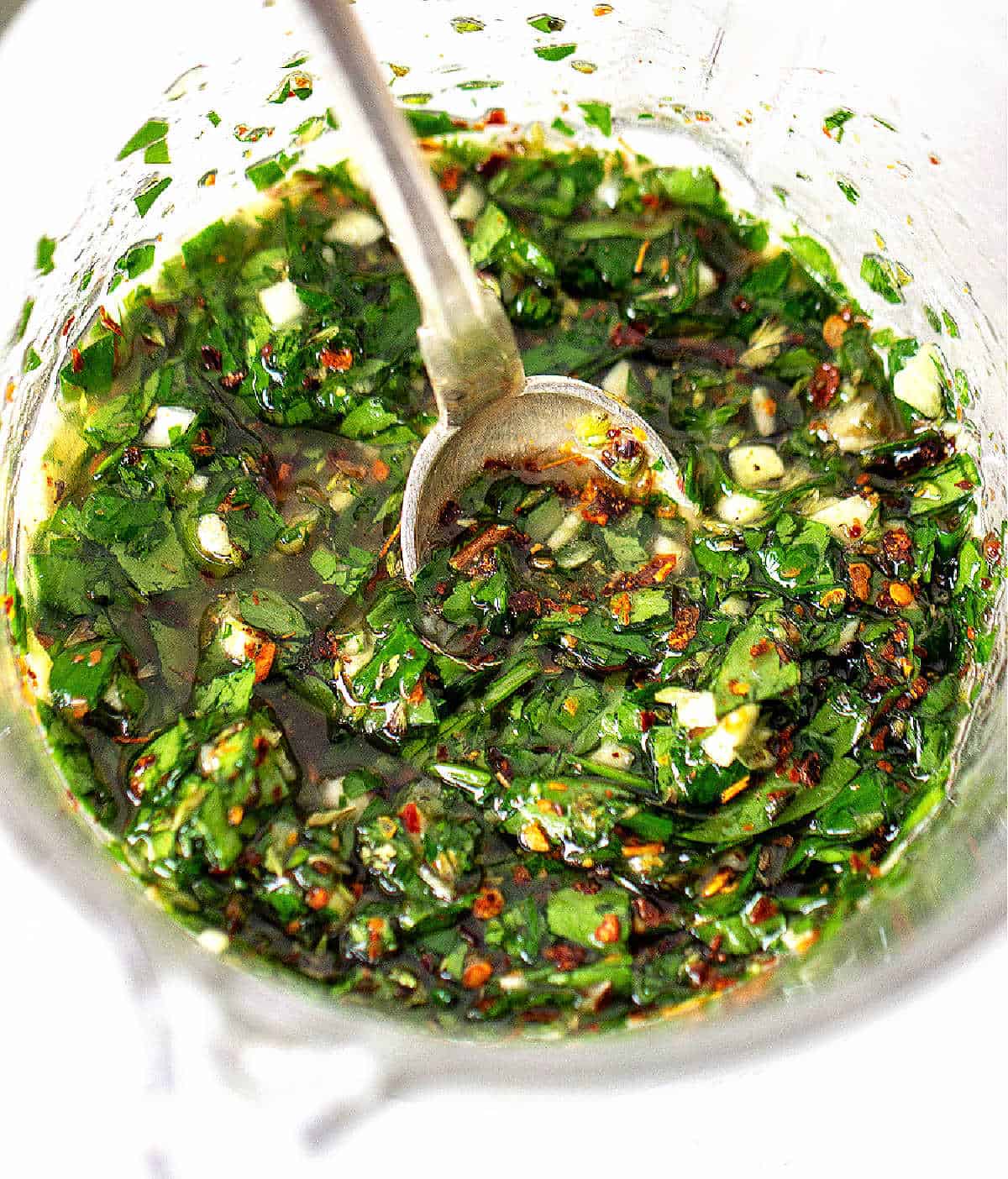
As an Amazon Associate, I earn from qualifying purchases. Please read my disclosure policy.
Chimichurri is most commonly used as a condiment for grilled meats, particularly beef, but it can also be used as a marinade or dressing for vegetables or salads.
It is known for its tangy, slightly spicy flavor and its bright green color. It's ridiculously simple to make, you can have it ready fast.
You can have it in the fridge for a few weeks, though the color will start to change and not be as bright.
In case you're wondering, the correct pronunciation of chimichurri is "chee-mee-CHOO-ree".
It has become increasingly popular outside of Argentina and is now commonly found in restaurants and grocery stores around the world.
Why you'll love this spicy sauce
- Flavor and versatility: it shines with grilled meats but adds a burst of flavor to any dish. It can be used in a variety of ways, from a marinade for meat to a dressing for salads. It's a versatile sauce that can be used to enhance the flavor of many different dishes.
- Easy to make: it's a quick preparation and requires only a handful of simple ingredients. You can whip up a batch in just a few minutes.
- Healthy: it's made with fresh ingredients so it's a healthier alternative to many store-bought sauces that are loaded with sugar and preservatives.
- Impressive: if you're entertaining guests, serving chimichurri can be an impressive touch. It's a unique and flavorful sauce that will make your dishes stand out.
Now, I'm writing this from Argentina (where I'm from and where I live) and here, there are as many 'authentic' versions as there are persons.
We barbecue a lot - and I mean a lot - and this condiment is the thing to use as a topping on our beloved chorizo sandwiches, our flagship street food dish, and with any other barbecued meats.
Chimichurri is an acquired taste, one of those delicious sauces or condiments that you grow into after trying it with grilled meat and pork sausages.
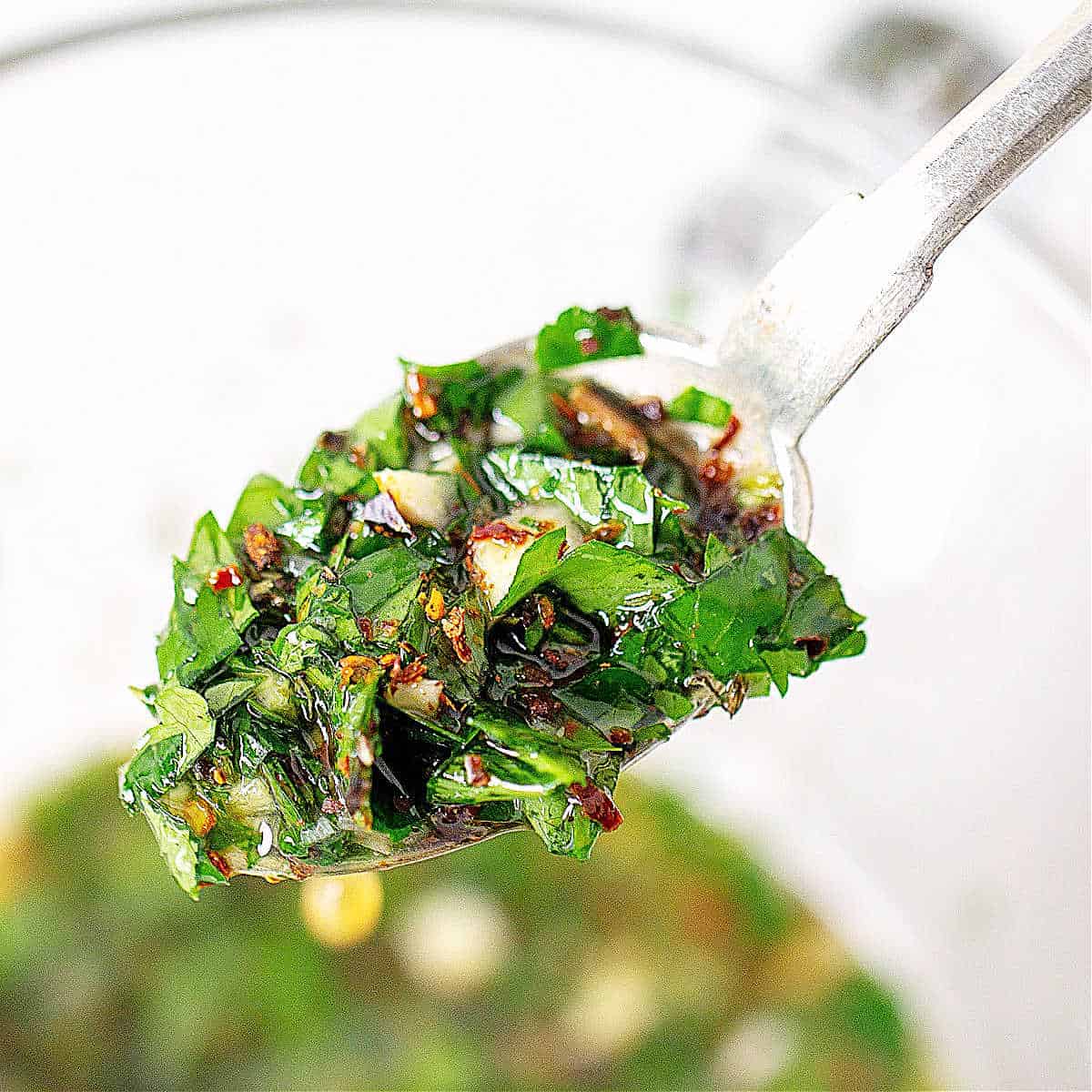
Ingredient list
Though we use fresh parsley, you can find ingredients for this condiment in dried form, which is how it was used way back, because they were more easily stored.
Dry part
- Parsley: fresh is better. Some would argue it was originally made with dried herbs. I think fresh parsley adds a lot to the final condiment, so that's what I use.
- Garlic: we use fresh cloves, but you find many who use dried flakes.
- Oregano: dried. Though you can use fresh oregano, the flavor is not as strong.
- Ají molido: our version of crushed red pepper flakes, it's a deep red color and has larger bits among the ground powder. It looks as if you mixed pepperoncino flakes with ground paprika. You can buy aji molido online.
- Salt and
- Black pepper: freshly ground is best, but packaged ground black pepper works.
Wet part
- Vinegar: red wine vinegar. The only vinegar used in an authentic chimichurri sauce.
- Oil: regular oil is used, sunflower or other cooking oil. Olive oil was never originally used in chimichurri simply because it wasn't widely available. But it does work very well.
- Water: it's a necessary ingredient when using all dried herbs and spices. Many recipes have more water than oil in them. It's a matter of personal taste.
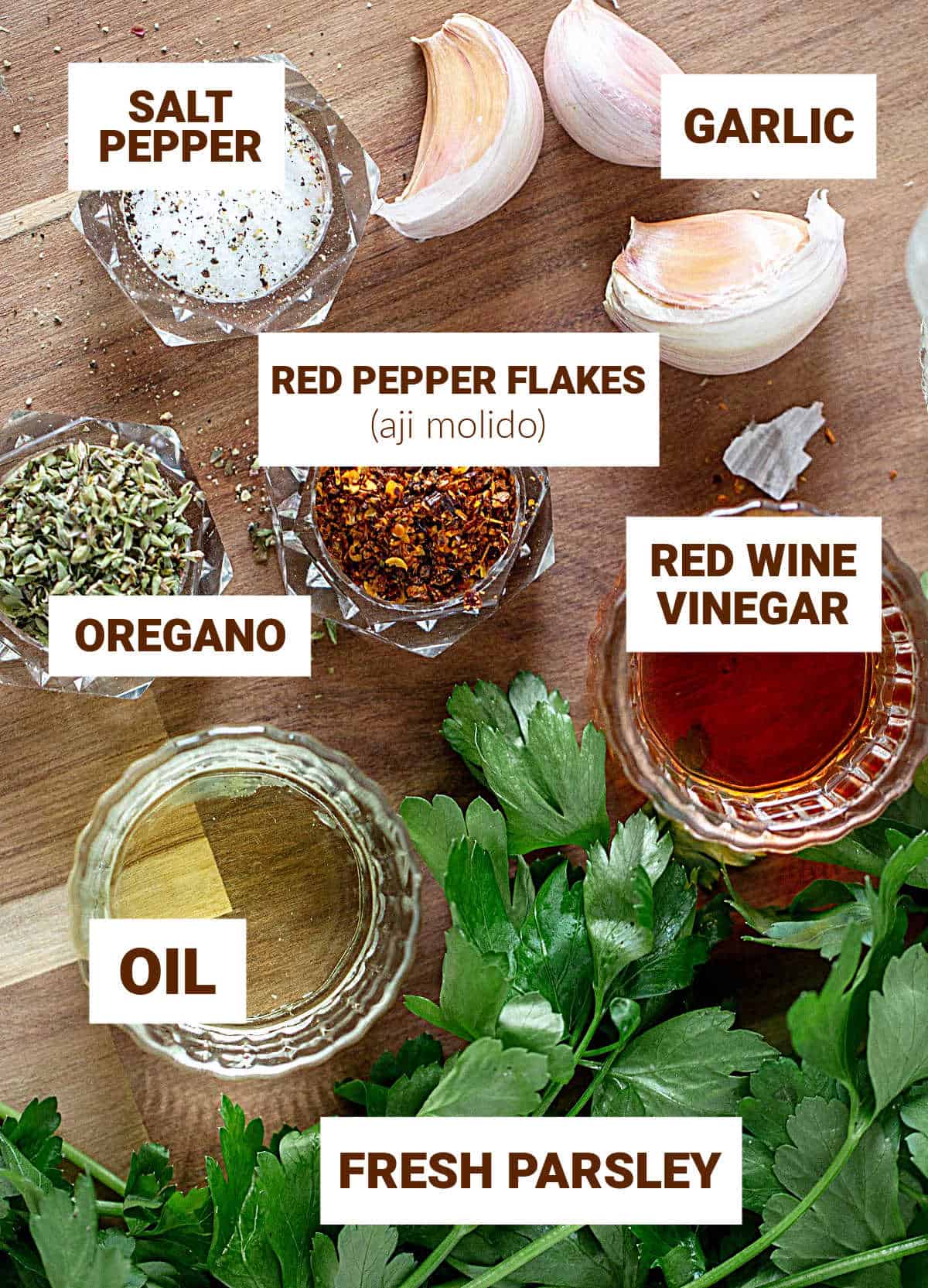
Variations & substitutions
This recipe is 1000% authentic, the one a true native (which I am) would post.
But I give variations on it so you can adapt it if needed. Or just because you want to experiment with something different.
- Cilantro: use it together with parsley. This is a widely used and common iteration.
- Different oils: olive oil (extra virgin if possible) is a popular substitution to use instead of sunflower. Try using other types like avocado oil or grapeseed oil to give the sauce a different texture and flavor.
- Adjust the heat level: make it milder by reducing the pepper flakes, or spicier by adding extra chili flakes, cayenne pepper, or fresh chili peppers to the traditional recipe to give it a spicy kick.
- Smoky: use smoked paprika or chipotle peppers to the sauce to give it a smoky flavor.
- Onions: replace the red wine vinegar with white wine vinegar and add some chopped green onions or scallions.
- Change the acidity: the original recipe uses vinegar, but you can experiment with using different types of vinegar or citrus juices like lime or lemon. This can give the sauce a different tangy flavor.
- Garlicky: use more cloves than what the recipe recommends.
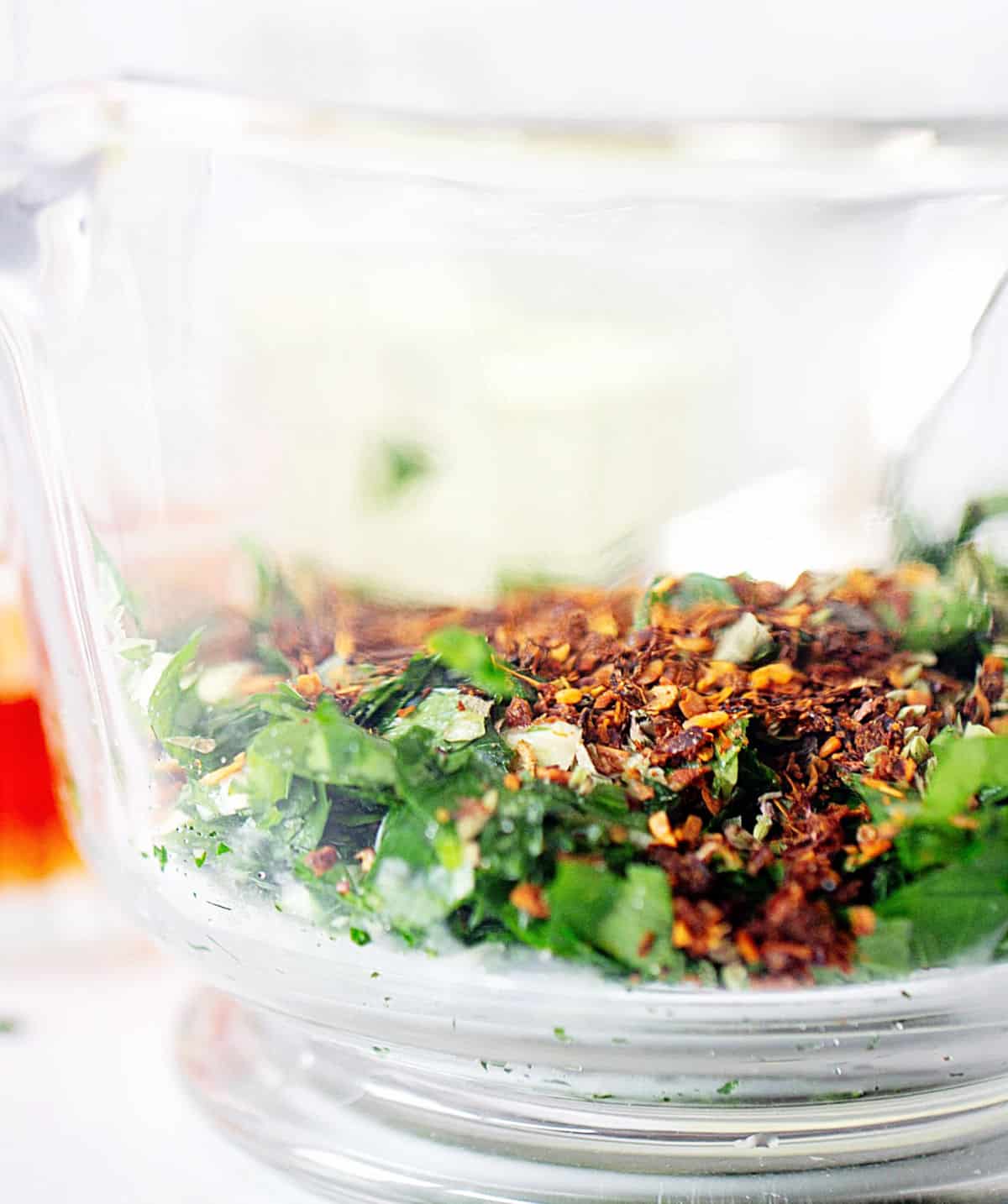
How to make chimichurri
It's a matter of chopping and mixing.
You can use a bowl or jar to mix it and transfer it to another one with a tight-fitting lid when storing it.
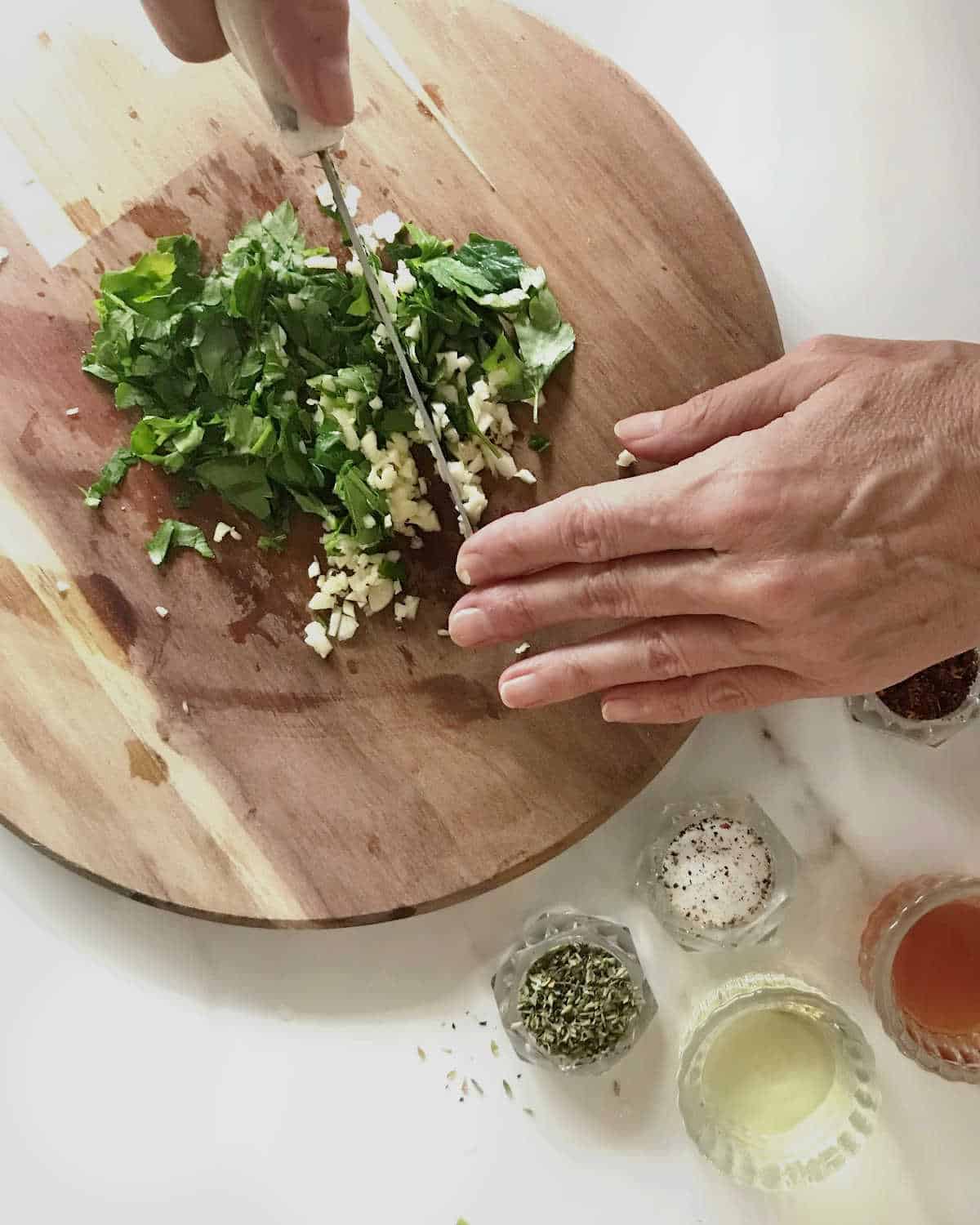
Chopping: chop the fresh parsley and garlic cloves together. It's a coarse mixture, with lots of texture.
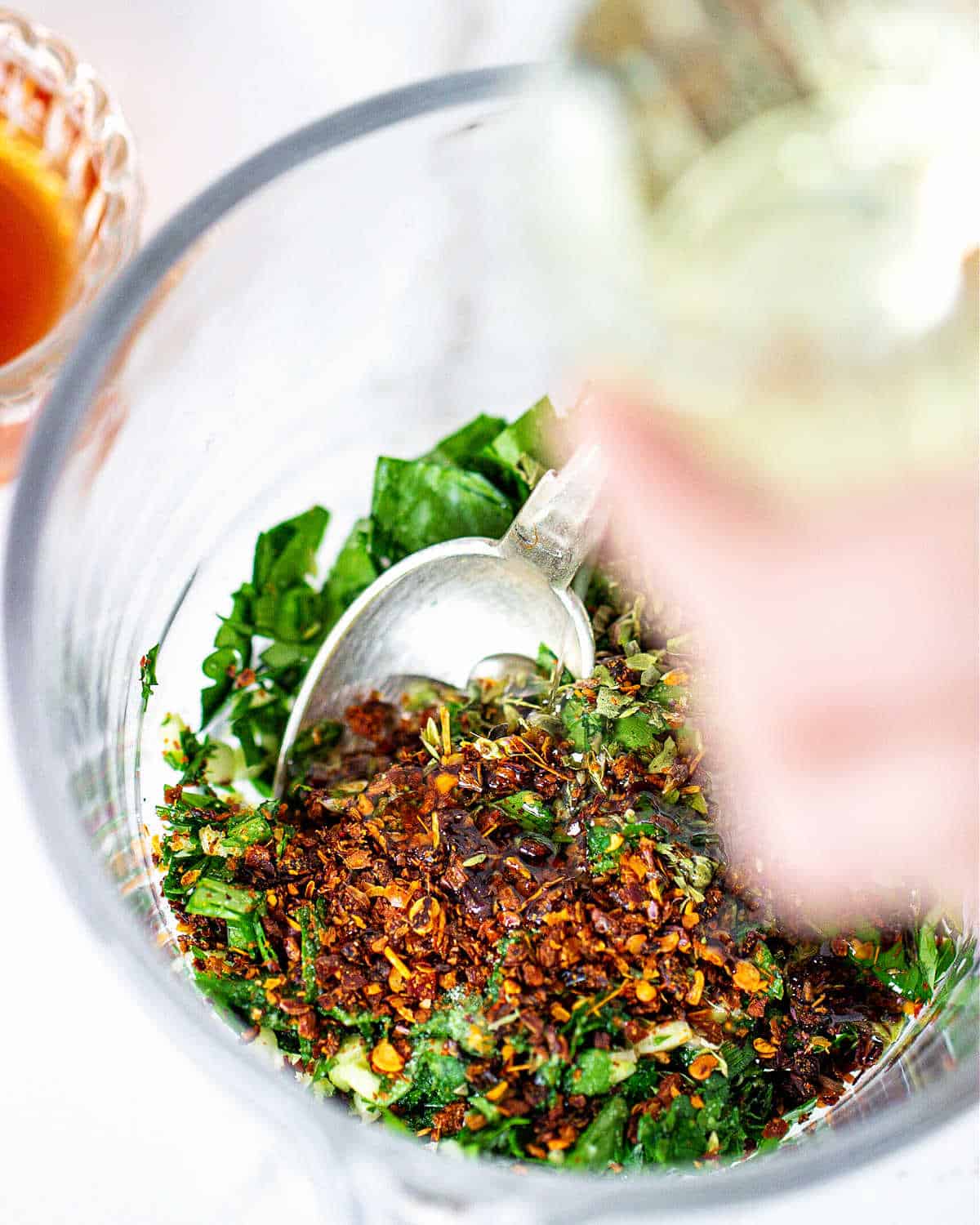
Mixing: then you simply add the rest of the dry ingredients and the liquids. It will be coarse and strange if it's your first time tasting it but know that the stay in the fridge will mellow it out and bring the flavors together.
Vintage Kitchen tip: use a mason jar or similar glass container with a tight-fitting lid to store it. It's normally kept for several weeks in the refrigerator. If you use plastic ones, the flavor will seep into them and you'll never be able to get it off. Or almost. If you do that, it will forever be the chimichurri container.
Origin
Chimichurri sauce is our traditional condiment that originated here in Argentina. Probably the one we identify with the most.
There are several stories about its origin.
The most common says that the name is a deformation of 'gimme curry', a sentence used by the English settlers living here, referring to the sauce as curry.
It spread to other parts of South America, mostly Uruguay.
Facts about chimichurri
- Texture: the sauce is not overly oily, it's pungent with garlic and vinegar flavors and even a bit coarse on the mouth.
- Flavor: It's literally watered down, otherwise, it would be just vinegar-tasting, despite the oil that is added to it. A couple of days of marinating in the fridge makes the flavors meld together and produce a better, more cohesive result.
- Food processor or blender: they're never used to make chimichurri. But if you like it pesto-style, go ahead.
- Health benefits: chimichurri is a low-calorie, low-fat sauce that is rich in antioxidants and other beneficial nutrients from fresh herbs.
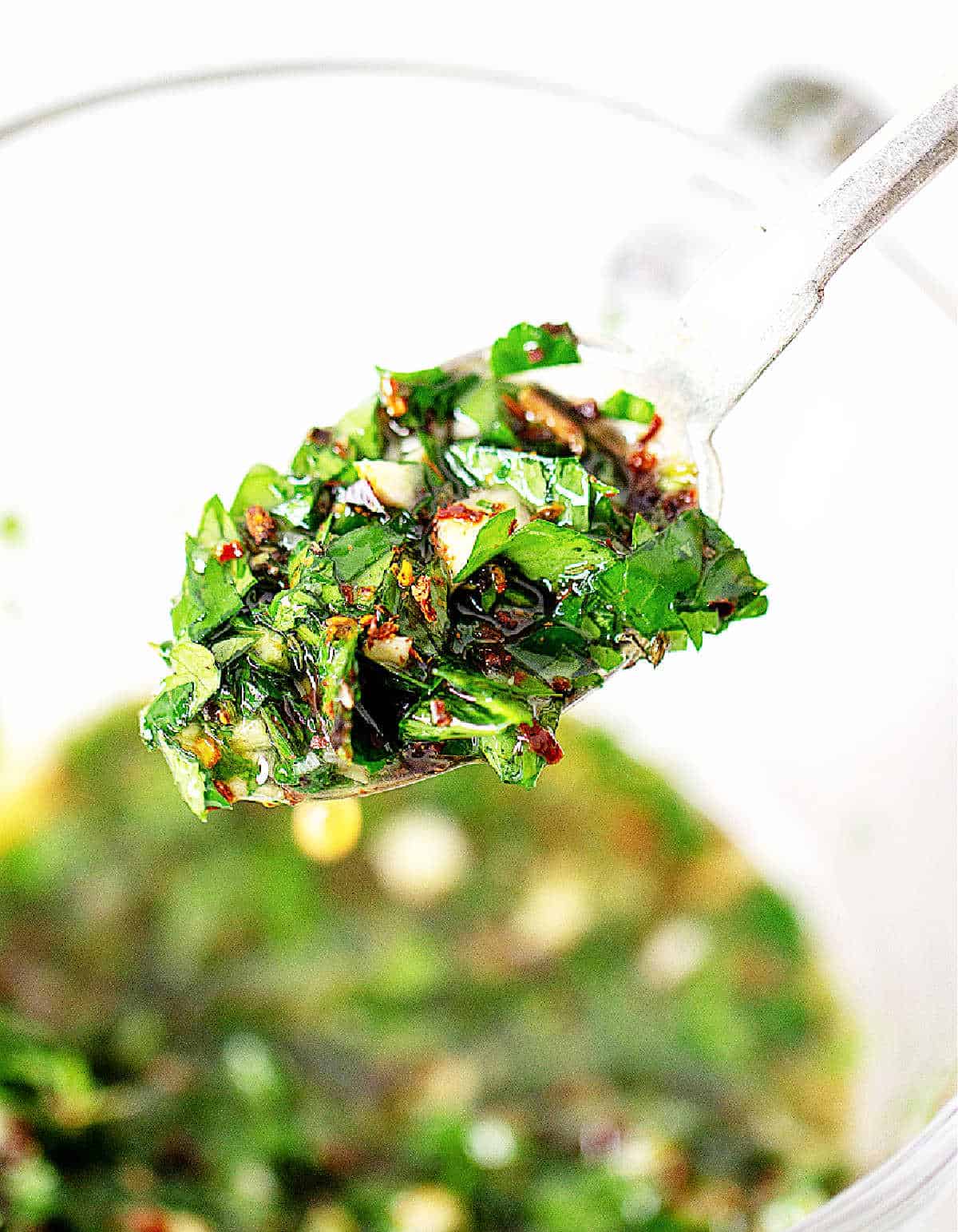
Kitchen notes
- Use fresh parsley: it does make a difference. I almost double sometimes the amount of chopped parsley stated in this recipe because that's how I roll.
- Olive oil: I use it more than not lately because that's what I always have in my house. So choose your favorite oil and go with it.
- Resting period: I like to make 1 or 2 days ahead. As with most condiments, the flavors meld and improve greatly. Be careful of the amount of salt and garlic as it can become too strong after a few days.
- Ají molido: in Spanish ají means pepper and molido means ground. You can buy aji molido (triturado) online or can use a mixture of crushed red pepper flakes and paprika. Or use chopped fresh red chilies.
- Dried herbs and garlic: in an emergency, you can use only dried herbs and dried garlic. Simply add vinegar, oil, and water, and just like that you have instant chimichurri with little work. The truth is that here they sell chimichurri as a spice mix which is just what I explained before.
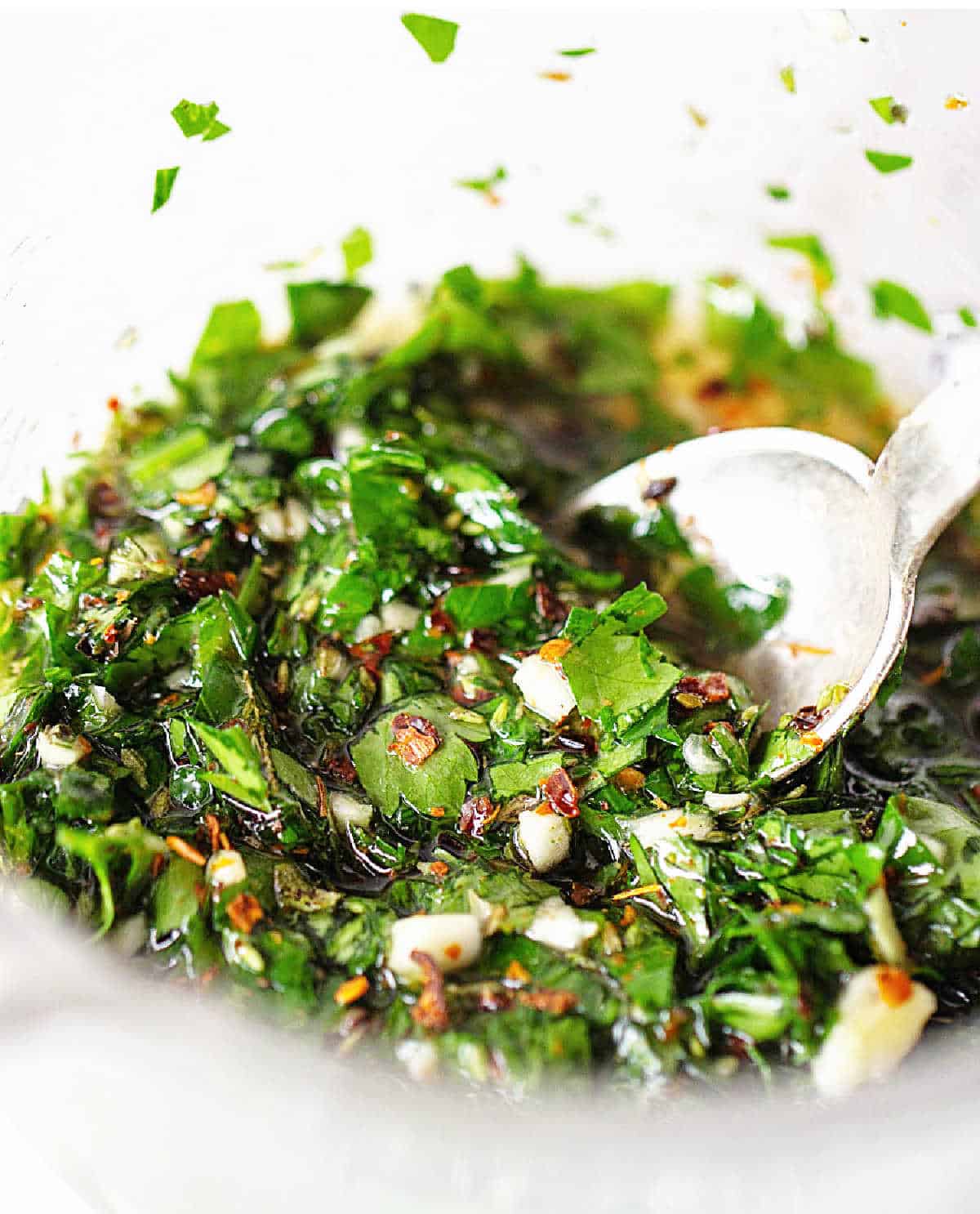
How long does chimichurri last?
It can last for days or weeks in the refrigerator if stored in an airtight container. The color will not be as bright and the flavors will deepen, making it spicier and not as fresh.
Can I freeze chimichurri?
Yes, it can be frozen for several months if stored in an airtight, freezer-friendly container.
Is chimichurri spicy?
It can be depending on the recipe and the amount of red pepper flakes or other spicy ingredients used.
Ways to use chimichurri
- Grilled meats: chimichurri is most commonly used as a condiment for grilled meats, particularly beef. It pairs well with steak, chicken, pork, and lamb.
- Vegetables: serve grilled or roasted vegetables with this parsley sauce. It adds a bright, tangy flavor to veggies like eggplant, zucchini, and bell peppers.
- Salads: it can be used as a salad dressing, particularly for hearty greens like kale or spinach. It can also be drizzled over a chopped vegetable or pasta salad for added flavor.
- Sandwiches and wraps: spread it on sandwiches and wraps as a flavorful alternative to mayonnaise, mustard, or pesto. Or mix it with mayonnaise for a tangy, spicy variation.
- Dipping sauce: it can be served as a dip or dipping sauce for bread, crackers, or veggies.
Related recipes you might like:
Let me know in the comments below if you made this recipe and loved it and if you had issues so we can troubleshoot together. I love to hear what you think, always. Thanks for being here. It's much appreciated.
You might also consider subscribing to our FREE Baking the Best email series and our regular newsletter. Or connect via Facebook, Instagram, and Pinterest.
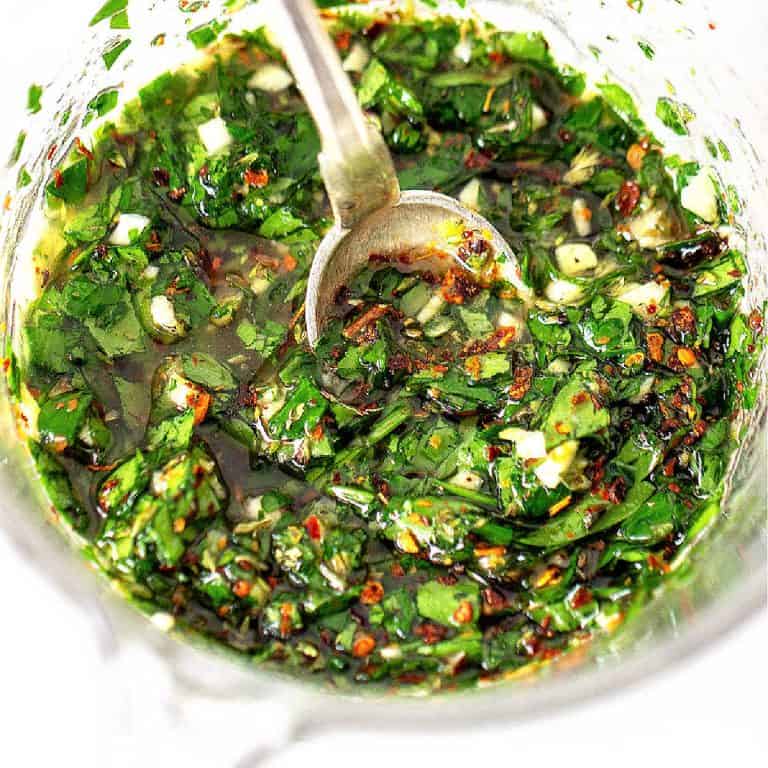
Chimichurri Recipe
This is an authentic chimichurri sauce recipe from Argentina, the real deal. A flavorful sauce made with a combination of fresh parsley, garlic, oil, vinegar, and red pepper flakes that comes together in 15 minutes and is the perfect condiment for barbecued meat, grilled chicken, sandwiches, and chorizo.
- Total Time: 15 minutes
- Yield: 1 cup
Ingredients
- 2 garlic cloves, chopped
- 1 tablespoons dried oregano
- 1 tablespoon aji molido (or smoked hot paprika and crushed red pepper flakes)
- 4 tablespoons chopped fresh parsley, a large bunch
- 5 tablespoons sunflower oil
- 2 tablespoons sherry or red wine vinegar
- 3 tablespoons water
- ½ teaspoon salt
- Freshly ground black pepper
Instructions
- Mix all dry ingredients - parsley, garlic, oregano, red pepper flakes - together in a glass jar.
- Add water and vinegar and mix well.
- Add oil, salt, and pepper and mix well.
- Check seasonings and adapt to your personal preference.
- Keep refrigerated in an airtight container, glass jar preferably.
Notes
- Ingredients: as with most savory sauces, they can be easily adjusted to your particular taste. And should, as you'll be the one eating it. Not only with the amount of each but also if you want to vary or substitute something. Add fresh cilantro in addition to the parsley, use smoked paprika or pepper flakes, less garlic, and olive oil instead of sunflower. I almost double the amount sometimes of parsley stated in this recipe. Make it your own.
- Use fresh parsley: it does make a difference. Dried can be used, but the chimichurri will lack freshness.
- Chopping: coarsely chop the garlic and parsley. There should be texture.
- Resting period: it's not mandatory, but I like to make it 1 or 2 days ahead. Many people don't, or at least they eat it as soon as they make it. As with most condiments, the flavors meld and improve greatly. Be careful with the amount of salt and garlic as it can become too strong after a few days, depending on how much you use. Keep that in mind if you're making it several days or weeks in advance.
- Ají molido: you can use a mixture of crushed red pepper flakes and paprika. You can buy aji molido (triturado) online.
- Dried herbs and garlic: in an emergency, you can use all dried herbs and dried garlic. Simply add vinegar, oil, and water to have instant chimichurri with little work. The truth is that here they sell chimichurri as a spice mix which is just what I explained before.
- Storing: it can last for days or weeks in the refrigerator if stored in an airtight container. The color will not be as bright and the flavors will deepen, making it spicier and not as fresh. And it can be frozen for several months if stored in an airtight, freezer-friendly container.
- Prep Time: 15 minutes
- Category: Condiments
- Method: Mixing
- Cuisine: Argentine
Nutrition
- Serving Size: ⅙
- Calories: 109
- Sugar: 0.1 g
- Sodium: 196.8 mg
- Fat: 11.5 g
- Carbohydrates: 1.6 g
- Fiber: 0.7 g
- Protein: 0.3 g
- Cholesterol: 0 mg


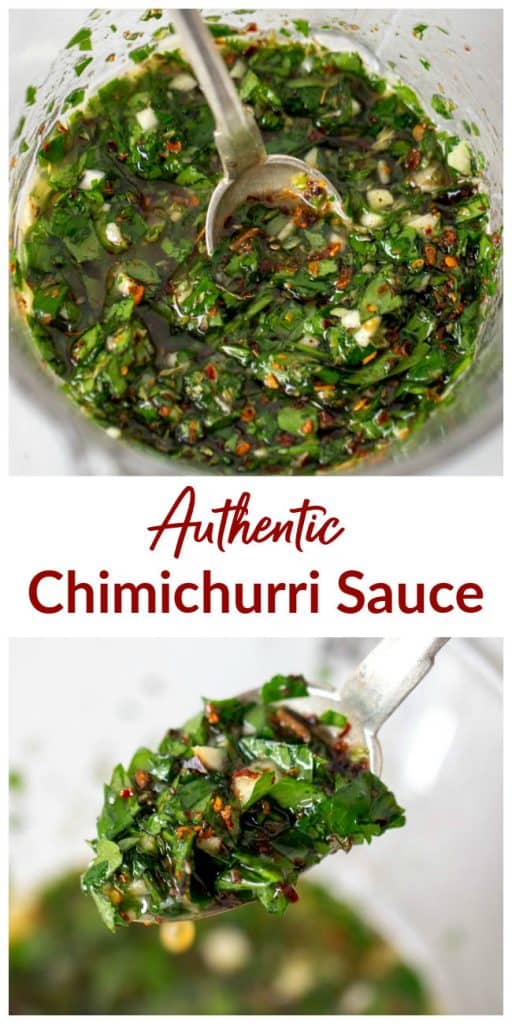
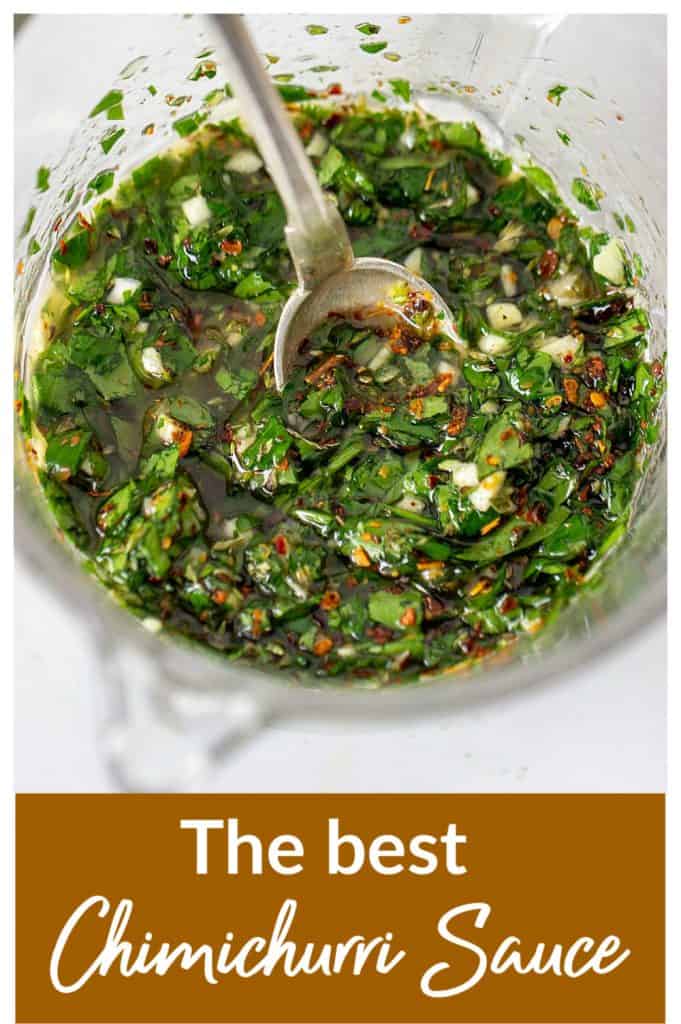
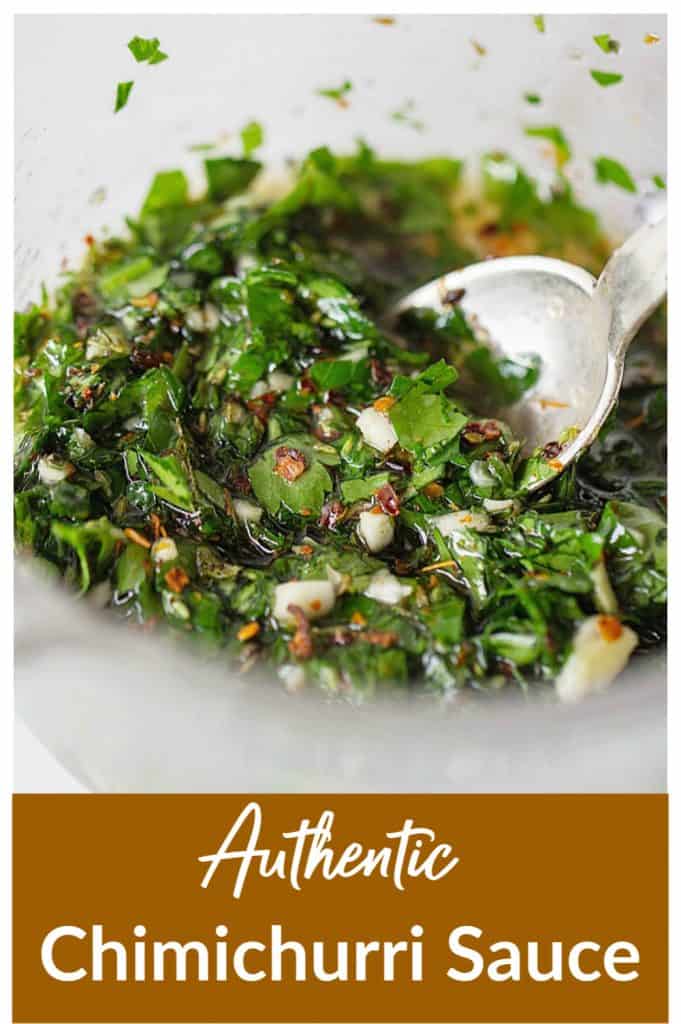
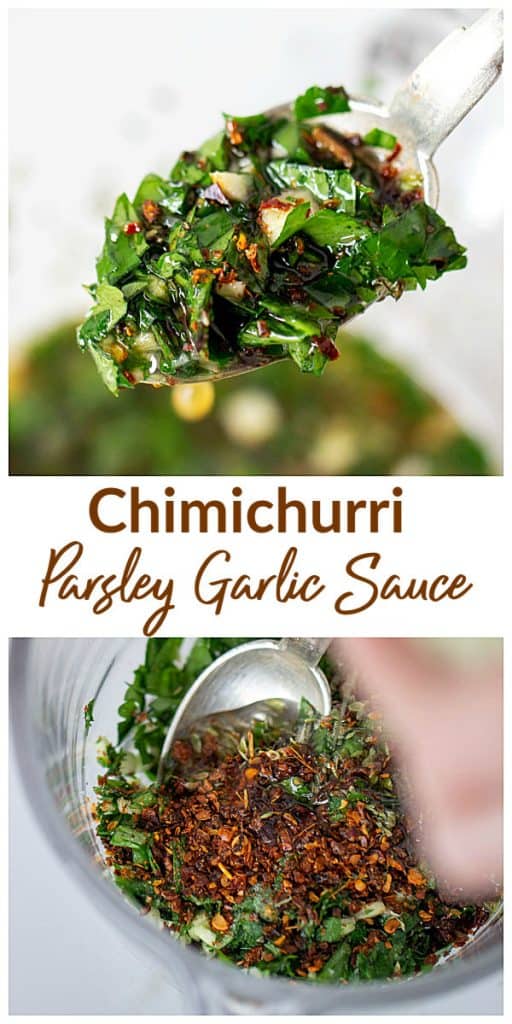
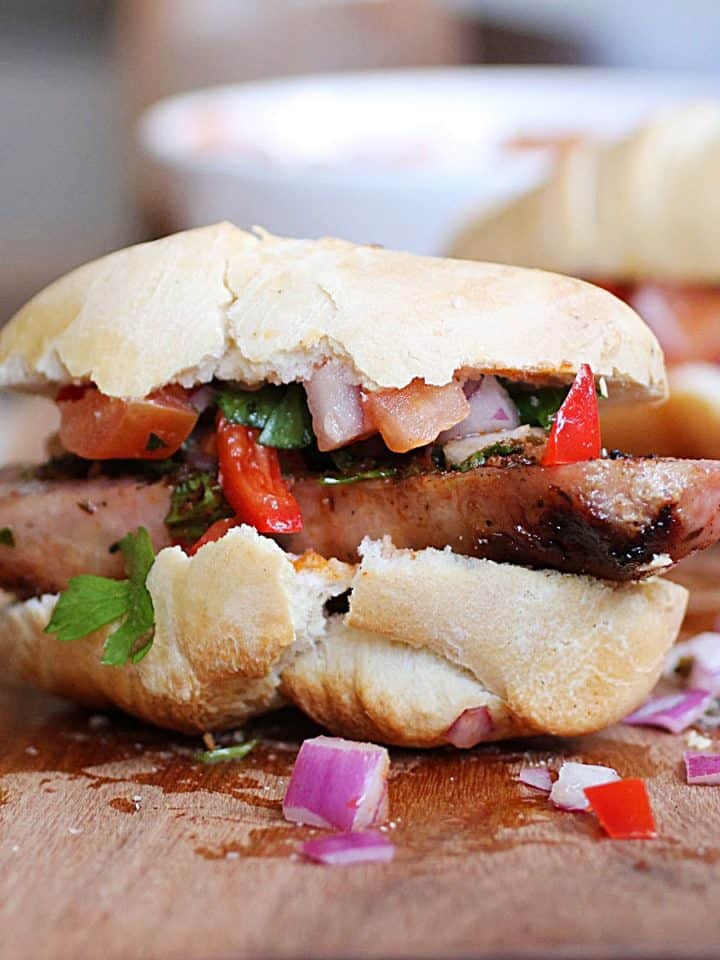
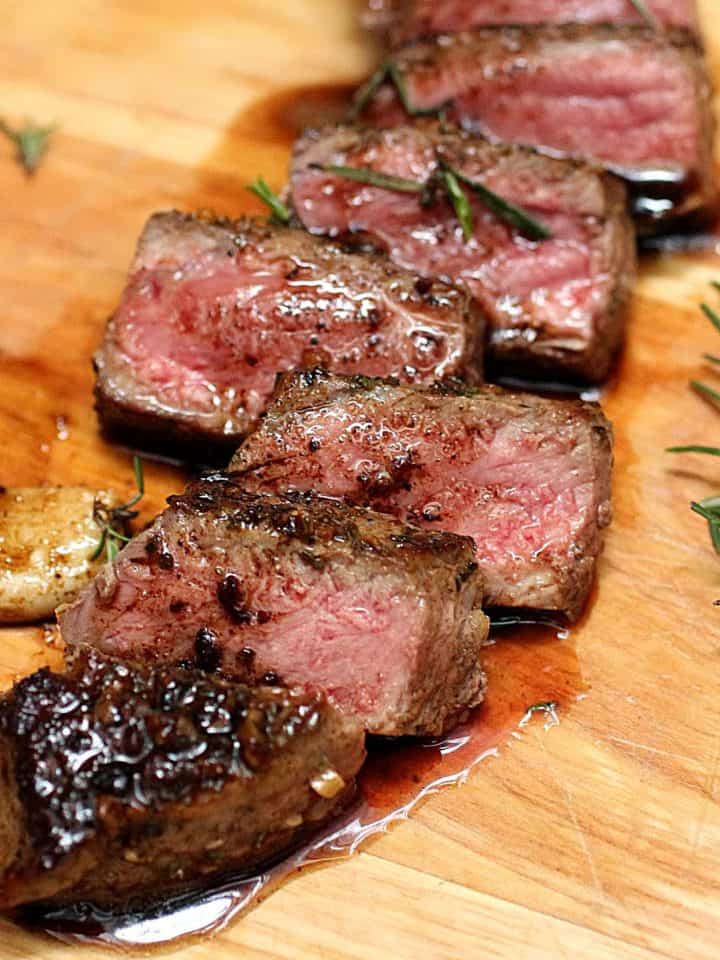
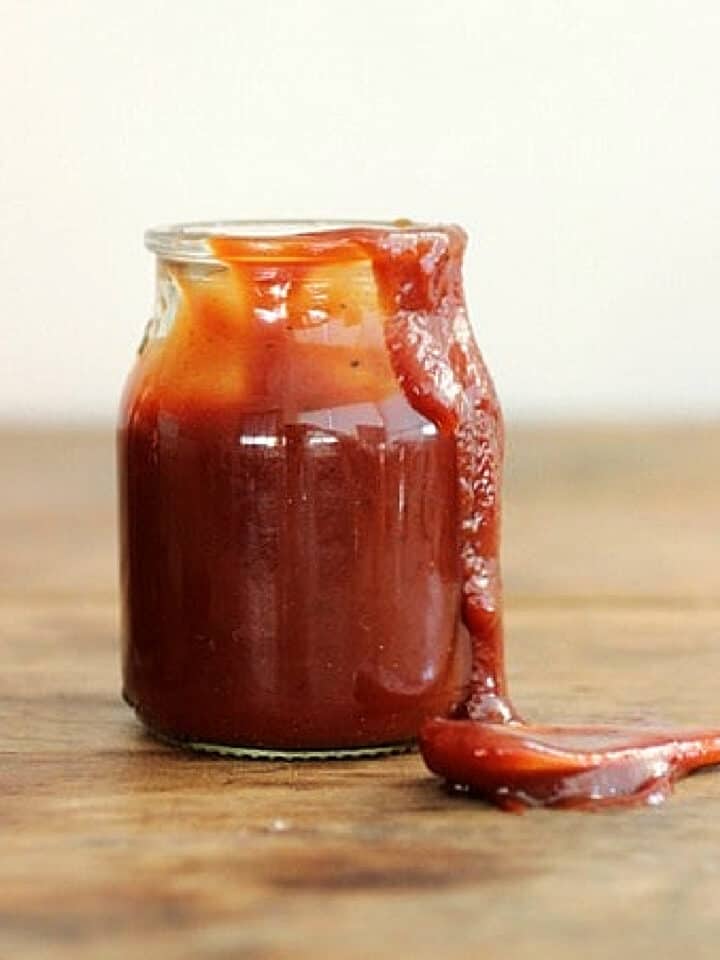
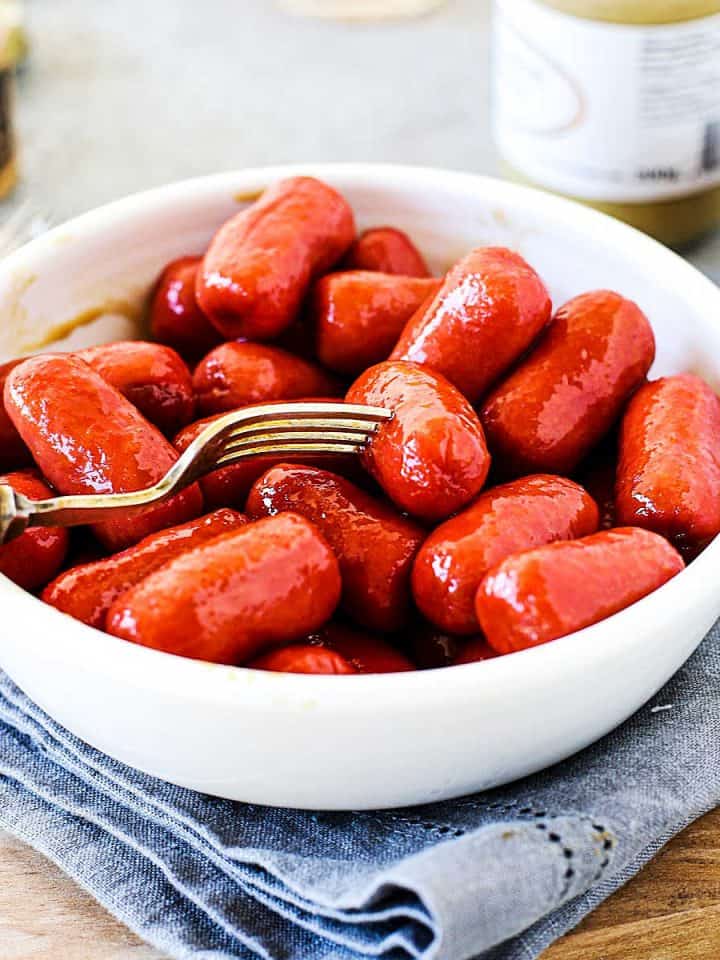
Judy B says
Delicious recipe; couldn't resist adding more parsley and some cilantro which we all love. Thanks for this recipe
Paula Montenegro says
Hi Judy, so happy you liked it! I know cilantro is a variation many people outside of Argentina like. And I'm happy it works well for you! Happy holidays.
Kim says
Made this tonight to go with some churrasco. I used all dried herbs except for a little oregano brujo I had out back. It was the best. My husband said it was the best he’s ever had. Will be making again. Saludos desde Puerto Rico!
Paula Montenegro says
Hi Kim! So happy to hear that! I do think it's the best also, and so easy to prepare, right? Have a great weekend.
Rachel Frampton says
I've been wanting to try a Chimichurri sauce on my dishes because I heard that this can help elevate its tastes. I'm glad you shared this; I'll make sure to prepare dried garlic flakes and crashes red pepper flakes for the ingredients. Whilst I'm perfecting one, maybe it would be best to buy one first from a reputable supplier.
Amy says
I love chimichurri! I appreciate how yours is authentic so when I go to prepare it for my guests I’m serving them the best! This recipe simply looks delicious—I can’t wait to try!
Shelley says
Why haven't I ever made chimichurri before?!? It's so delicious, and your explanations make it so very simple to get it right! And even better ... I love that you can (and actually should) make it ahead of time, which is terrific for busy nights! Thanks for this wonderful post!
Analida Braeger says
Chimichurri is sure to never disappoint. I havent tried it with sunflower oil though, but I'm definitely going to try it out !
Marisa F. Stewart says
The spicier the better - and Chimichurri Sauce is so good. I've bought the powder before and been a little disappointed. This homemade sauce is just what I've been looking for -- the tips are great and a way to insure success.
Jenni LeBaron says
I love serving chimichurri over so many dishes! Your recipe looks fantastic and easy. I've never heard of aji molido but I do use red pepper flakes in mine. I will have to watch out for that spice though. I'd love to try your version!
Aline says
Chimichurri is my favorite, and yes - there are a million variations out there, and I'm so happy I can now make the 1000000% authentic one!! 🙂 Thank you!!
Julie says
Who are these people making chimichurri with cilantro?! Don't get me wrong; I love cilantro, but it doesn't belong in chimichurri! It's one of my favorite summer condiments; so good on everything from fish to chicken to grilled vegetables.
Carrie | Clean Eating Kitchen says
I love chimichurri sauce! This looks so fresh and full of flavor! I'll ditch the store bought next time and give his recipe a go!
Anna says
I don't think I've ever had authentic chimichurri before, your version looks and sounds very flavoursome! Thanks for sharing all the tips and tricks to this recipe, I'm definitely going to make this very soon!
Elena says
This chimichurri sauce looks perfect for the grilling season! I appreciate that you gave variations on this authentic recipe in your post - I guess ají molido would be hard for me to find.
Kelly Anthony says
I make something very similar but with black pepper instead of the red pepper flakes. I bet it add an extra spice that makes this perfect.
Chef Dennis says
This Authentic Chimichurri recipe from Argentina looks really tasty! Perfect for our BBQ and Grill. I must try this soon!
juliana says
Please invite me to an asado!
angiesrecipes says
My favourite! I can't wait to try your recipe!
Paula Montenegro says
Let me know what you think Angie!
David Scott Allen says
As you know, I have to make my chimichurri sauce sin ajo. I know that sounds criminal but I have no choice. I use garlic chives instead, as it is the best I can do and it’s still very flavorful. I like to serve I with grilled mollejas.
Paula Montenegro says
I know, and I'm glad you make it anyway! And mollejas, I'm a raving fan, so much so that I was telling friends the other day that they would probably be my last meal hahaha!
David Scott Allen says
I’m so relieved you are okay with my switch out for the chimichurri!
So few people here eat mollejas! I had them in a wonderful bistro in Santiago de Chile. If you ever get there check our Ambrosia Bistro.
Paula Montenegro says
I will! Did you have them grilled? All creamy inside and crunchy outside?